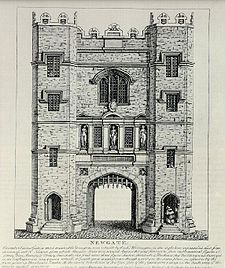It was rebuilt several times, including by Christopher Wren (who else?) after the Great Fire of London in 1666. The last version, pictured below, was erected in 1782. It was designed by another prolific architect, George Dance the Younger.
"New" Newgate became the scene of public executions the following year, when they were moved from Tyburn (near today's Marble Arch) to outside the prison gates. The authorities made the move because the traditional processions to Tyburn and the hangings attracted large and boisterous crowds, and sometimes produced riots.
Nevertheless, large crowds also gathered to watch the hangings at Newgate. They often paid large sums for good observation posts. Hawkers sold "confessions" of the condemned as well food and drink to the crowds. Public executions were much like modern sports events, except everyone knew in advance who was going to lose.

That sort of entertainment ended in 1868, when the authorities removed the executions from the public gaze altogether. Henceforth, they took place inside the prison walls. An illustration by French artist Gustave Dore of the prisoners' exercise yard around that time captures the grimness of life in Victorian Newgate.
Newgate closed in 1902 and was demolished. It is now the site of London's Central Criminal Court, which was moved from its earlier location nearby. It has long been known as the Old Bailey after the street it fronts upon. A statue of Justice upon its roof announces its purpose, if not always its results.
Famous prisoners of Newgate included Ben Jonson, Daniel Defoe, alleged pirate Captain William Kidd, Casanova, and William Penn, the founder of Pennsylvania. Of this group, only Kidd was executed, but he was hanged at Wapping Dock on the River Thames, as was the custom with pirates.





No comments:
Post a Comment